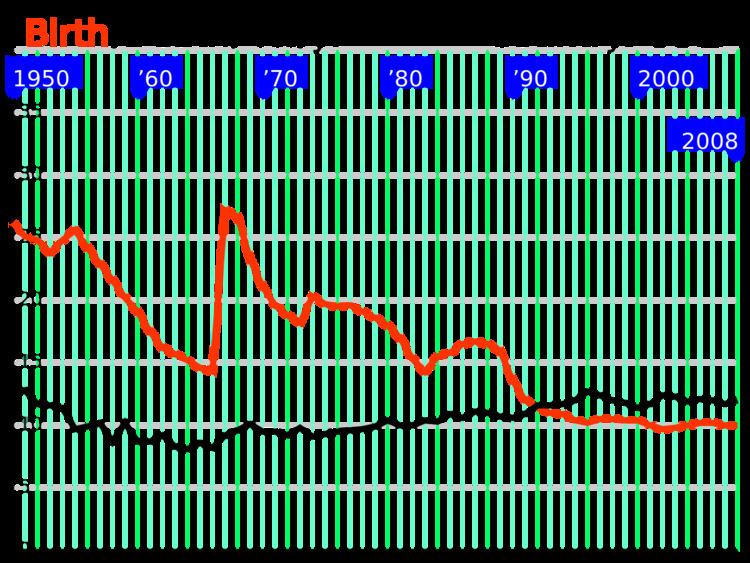 | ||
Decreței (from the Romanian language word decret, meaning "decree"; diminutive decrețel) are Romanians born in the late 1960s and 1970s, shortly after the communist regime of Nicolae Ceaușescu issued Decree 770, aimed at the creation of a new and large Romanian population by restricting abortion and contraception.
Contents
Origin of the decree
Before 1967, the Romanian abortion policy was one of the most liberal in Europe. Because the availability of contraceptive methods was poor, abortion was the most common means of family planning.
Through a combination of modernization of the Romanian community, the high participation of women in the labor market and a low standard of living, the number of births significantly decreased since the 1950s, reaching its lowest value in 1966. However, the leaders saw the decreasing number of births mainly as a result of the decree issued in 1957 that legalized abortion.
To counter this sharp decline of the population, the Communist Party decided that the Romanian population should be increased from 23 to 30 million inhabitants. In October 1966, decree 770 was authorized by Ceaușescu. Abortion and contraception were declared illegal, except for:
Enforcement
To enforce the decree, society was strictly controlled. Contraceptives disappeared from the shelves and all women were forced to be monitored monthly by a gynecologist. Any detected pregnancies were followed until birth. Secret police kept their eye on operations in hospitals closely.
Sex education was refocused primarily on the benefits of motherhood, including the ostensible satisfaction of being a heroic mother who gives her homeland many children.
The direct consequence of the decree was a huge baby boom. Between 1966 and 1967 the number of births increased by almost 100%, and the number of children per woman increased from 1.9 to 3.7. The generation born in 1967 and 1968 was the largest in Romanian history. Hastily, thousands of nursery schools were built.
Circumvention and mortality
In the seventies, birth rates declined again. Economic pressure on families remained, and people began to seek ways to circumvent the decree. Wealthier women were able to obtain contraceptives illegally, or bribed doctors to give diagnoses which made abortion possible. Especially among the less educated and poorer women there were many unwanted pregnancies. These women could only utilize primitive methods of abortion, which led to infection, sterility or even their own death. The mortality among pregnant women became the highest of Europe during the reign of Ceaușescu. While the childbed mortality rate kept declining over the years in neighboring countries, in Romania it increased to more than ten times that of its neighbors.
Many children born in this period became malnourished, were severely physically handicapped, or ended up in care under grievous conditions, which led to a rise in child mortality.
Romanian orphans
A consequence of Ceaușescu's natalist policy is that large numbers of children ended living in orphanages, because their parents could not cope. The vast majority of children who lived in the communist orphanages were not actually orphans, but were simply children whose parents could not afford to raise them.
Romanian revolution
In their book Freakonomics, authors Steven Levitt and Stephen J. Dubner make the argument that children that are born after their mothers are refused an abortion are much more likely to commit crimes or refuse to recognize authority when they reach adulthood. They further argue that the Decreței are exactly the same people who spearheaded the effort to violently overthrow Ceaușescu's regime in 1989. In that year, the oldest Decreței would have been 22 years old, in the general age range of most revolutionaries. Levitt and Dubner note that Romania was the only east-European communist country with strict anti-abortion and anti-contraception laws at the time, and also the only country whose ruler was violently overthrown and killed at the end of the Cold War. Most other such countries experienced a tumultuous, but peaceful, transition. There were however other aspects of totalitarian rule that would promote violent reaction instead of peaceful transition, including a lack of associational life and legal gatherings, a more extensive system of informants and special police than any state other than East Germany, and a cult of personality built up around the supreme leader. The actual violence of the revolution can be attributed to divisions among the ruling and military/secret police and the vacuum of power that resulted. Revolutions are often observed to come in waves and it is likely that Romania would have experienced it no matter its demographic situation.
Abortion after 1990
Although in the early 1990s, shortly after abortion was legalized, the abortion rate was very high, it has gradually decreased, as more couples stated using contraception, and the economy also started to improve after the instability of the transition. According to the National Institute of Statistics, the rate of abortions since 1990 is as follows:
